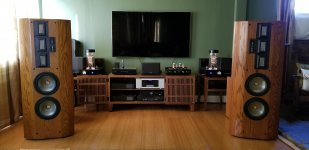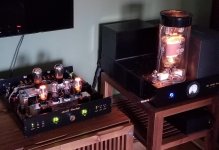The Burson V6 Classic and Vivid are advertised as FET-input opamps, yet their data sheets show 170uA of typical input bias current, which is high even for a BJT opamp. For example, the BJT-input Sparkos opamp has about 5uV and the FET-input Staccato opamp has 1nA.
Am I missing something here? I'm considering the Bursons for an EQ unit I have but I need a FET-input and the Burson datasheet makes me question it's applicability. I'm currently running OPA827s on Browndog adapters (picoamp level Ib).
Any clarification is appreciated!
Am I missing something here? I'm considering the Bursons for an EQ unit I have but I need a FET-input and the Burson datasheet makes me question it's applicability. I'm currently running OPA827s on Browndog adapters (picoamp level Ib).
Any clarification is appreciated!
Last edited:
To get to the 827 I went through the LF353 (stock unit), OPA2134, OPA2107, and finally OPA827 in the bass gain section of the EQ unit. In the output stage the 827 was easily bettered by the Burson V4 discrete opamp, probably because the Burson runs at 20 mA quiescent current vs 4.8mA for the 827 - the bass drive was clearly better with the Burson.
I'm curious whether the 827 is really "it" or whether it can he bettered in the non-output stage too. I tried the BJT-input Sparkos SS3602 there but it wasn't stable; I had a rustling/rumbling noise in the speakers. It did seem to give a bit better bass definition than the 827 aside from the noise. Sparkos took it back for a full refund.
My goal is to make this necessary evil EQ unit as transparent as possible so it doesn't get in the way of my REAL electronics...the 01A tube DAC/preamp and 833C tube power amp.
Now is there any reason why a FET-input opamp, diecrete or IC, would have such a large Ib?
I'm curious whether the 827 is really "it" or whether it can he bettered in the non-output stage too. I tried the BJT-input Sparkos SS3602 there but it wasn't stable; I had a rustling/rumbling noise in the speakers. It did seem to give a bit better bass definition than the 827 aside from the noise. Sparkos took it back for a full refund.
My goal is to make this necessary evil EQ unit as transparent as possible so it doesn't get in the way of my REAL electronics...the 01A tube DAC/preamp and 833C tube power amp.
Now is there any reason why a FET-input opamp, diecrete or IC, would have such a large Ib?
Last edited:
Very interesting! Yet their datasheet shows Ib of 170uA typical! Something doesn't add up...
SS-Opamp-V6-datasheet-V1.1.pdf - Google Drive
SS-Opamp-V6-datasheet-V1.1.pdf - Google Drive
First step is to define the problem and undertake measurements, is this okay? Review the circuit, what is the output driving ? We have no definition of "it".
What is it about the circuit that makes the OPA827 unsuitable ?
There is a difference between the quiescent current and op-amp output drive current. The OPA827 can output 30mA, 12v into 600R is 20mA.
Is there something wrong with the circuit ? Randomly Swapping op-amps without understanding op-amp characteristics can make the circuit unstable.
What characteristics do these boutique audiophile discrete op-amps offer that surpass any op-amp from TI or Analog Devices.
What is it about the circuit that makes the OPA827 unsuitable ?
There is a difference between the quiescent current and op-amp output drive current. The OPA827 can output 30mA, 12v into 600R is 20mA.
Is there something wrong with the circuit ? Randomly Swapping op-amps without understanding op-amp characteristics can make the circuit unstable.
What characteristics do these boutique audiophile discrete op-amps offer that surpass any op-amp from TI or Analog Devices.
Thanks for the advice. The Sparkos made the circuit unstable as I suspected it might, considering the opamp is fed from a 1Mohm pot and has a 40K feedback resistor. Sparkos money-back guarantee made me say "why not try it", so I did. Now I will try the Burson V6 Vivid next as it is FET-input.
I like to try new things sometimes, even if the current solution is very good, just in case there's something better. In the case of a socketed opamp swap, why not try it - it doesn't get any easier to try than that!
I don't feel the same way with my 180lb 2.3kV plate voltage 833C mono amps...it's not so easy to play with them!
I like to try new things sometimes, even if the current solution is very good, just in case there's something better. In the case of a socketed opamp swap, why not try it - it doesn't get any easier to try than that!
I don't feel the same way with my 180lb 2.3kV plate voltage 833C mono amps...it's not so easy to play with them!
Last edited:
Without measurements or a circuit diagram there's not much to achieve here, rather than undertaking basic engineering the solution seems to be throwing handfuls of op-amps and expending lots of money at a circuit and hoping it will magically come to fruition.
My goal is to make this necessary evil EQ unit as transparent as possible so it doesn't get in the way of my REAL electronics...the 01A tube DAC/preamp and 833C tube power amp.
Conceptually this is just wrong. If that EQ is really essential you should find other ways to achieve it.
Conceptually this is just wrong. If that EQ is really essential you should find other ways to achieve it.
Rather judgemental, I think. The EQ is part of the speaker system from Infinity circa 1985. It is needed to overcome the rising woofer impedance in the 20-40Hz range and give flat response to 20Hz. The rest of the signal is supposed to pass through unchanged but that was not the case in stock form. The EQ sits between the preamp and the amps.
The stock unit severely limited the sound quality, so I pretty much gutted it and the only stock parts left are the box, knobs and one PCB. I built an outboard choke input power supply and a new output stage using an opamp follower, and upgraded the crappy polyester caps, resistors, pots and jacks as well. It sounds extremely transparent now but I'm always curious about how new parts can change the sound so I tweak it occasionally. For example, changing the OPA827s in the output follower to Burson V4 discretes definitely improved the bass impact and depth, no doubt about it. Better input caps and removing the output caps completely (DC coupled from the opamp follower) allowed the mids and treble to pass through in all their glory.
It sounds great now, and only my relentless pursuit of perfection keeps me tweaking it. Well, that and my curious nature as a scientist.
Attached is a pic of the system and one showing my preamp/DAC with the lid off. I designed and built the DAC/Preamp and the mono amps myself. The preamp uses UX-201A directly heated triode tubes (circa 1925), fed from a gas-tube regulated, all choke input supply. The amps are SETs featuring 833C transmitter tubes run at 2.3kV - pure class A1 up to 40W, A2 above that to 200W. From an SET. The speakers are Infinity RSIIb refurbished by me with external passive crossovers.
So, all I came here for was to share my puzzlement at the Burson spec sheet Ib value, and to ask if there was a good reason for it other than pure error. I didn't want to debate about the merits of discrete vs IC or any other religious convictions. I'm a tube guy, anyway, so I couldn't care less except for how it impacts the sound of my lovely tubes.
Attachments
Last edited:
Any answer from burson?Rather judgemental, I think. The EQ is part of the speaker system from Infinity circa 1985. It is needed to overcome the rising woofer impedance in the 20-40Hz range and give flat response to 20Hz. The rest of the signal is supposed to pass through unchanged but that was not the case in stock form. The EQ sits between the preamp and the amps.
The stock unit severely limited the sound quality, so I pretty much gutted it and the only stock parts left are the box, knobs and one PCB. I built an outboard choke input power supply and a new output stage using an opamp follower, and upgraded the crappy polyester caps, resistors, pots and jacks as well. It sounds extremely transparent now but I'm always curious about how new parts can change the sound so I tweak it occasionally. For example, changing the OPA827s in the output follower to Burson V4 discretes definitely improved the bass impact and depth, no doubt about it. Better input caps and removing the output caps completely (DC coupled from the opamp follower) allowed the mids and treble to pass through in all their glory.
It sounds great now, and only my relentless pursuit of perfection keeps me tweaking it. Well, that and my curious nature as a scientist.
Attached is a pic of the system and one showing my preamp/DAC with the lid off. I designed and built the DAC/Preamp and the mono amps myself. The preamp uses UX-201A directly heated triode tubes (circa 1925), fed from a gas-tube regulated, all choke input supply. The amps are SETs featuring 833C transmitter tubes run at 2.3kV - pure class A1 up to 40W, A2 above that to 200W. From an SET. The speakers are Infinity RSIIb refurbished by me with external passive crossovers.
So, all I came here for was to share my puzzlement at the Burson spec sheet Ib value, and to ask if there was a good reason for it other than pure error. I didn't want to debate about the merits of discrete vs IC or any other religious convictions. I'm a tube guy, anyway, so I couldn't care less except for how it impacts the sound of my lovely tubes.
- Home
- Amplifiers
- Chip Amps
- Burson V6 Discrete Opamps

